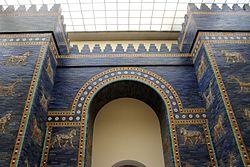کاتنامەی بەسرە
ڕواڵەت
| کاتنامەی بەسرە | |
|---|---|
| پۆتانی شوێن | ٣٠°٣٠′٠″N ٤٧°٤٩′٠″E |
 | |
ئەمانە کاتنامەی ڕووداوەکانی شاری بەسرە بەدرێژاییی مێژوو.
| مێژووی عێراق |
|---|
 |
|
|
پێش سەدەی ٢٠
[دەستکاری]- ٦٣٨ی زایینی - ئۆردوگای سەربازی لەلایەن ئوتبەی کوڕی غەزوانەوە دامەزرا بەپێی فەرمانی عومەر کوڕی خەتتاب.[١]
- ٦٤٦ - عەبدوڵڵای کوڕی عامر بوو بە حاکم.[٢]
- ٦٥٨ - شەڕی جەمەل.[١]
- ٦٦٤ - زیاد کوڕی ئەبیحی بوو بە حاکم .[٢]
- ٦٨٣ - ڕاپەڕین دژی ئومەوییەکان.[١]
- ٦٨٤ - حاکم مەسعوودی کوڕی عەمر لەلایەن عەساویرەوە لەژێر دەستی مەح-ئەفریدون کوژرا[٣][٤]
- ٩٢٣ - ململانێی قەرەمیتە .[٥]
- ١٠٥٢- گەشتیار ناسر خەسرەو سەردانی شار دەکات.[٦]
- ١٣٢٧ - گەشتیار ئیبن بەتووتە سەردانی شارەکەی کرد .[١]
سەدەی ٢٠
[دەستکاری]- ١٩٤٧ - ژمارەی دانیشتووان: ١٠١٥٣٥ کەس[٧]
- ١٩٦٤ - زانکۆی بەسرە دامەزرا[٨]
- ١٩٦٥ - ژمارەی دانیشتووان: ٣١٠٩٥٠ کەس.[٩]
- ١٩٨٧ - ژمارەی دانیشتووان: ٤٠٦٢٩٦ کەس.[١٠]
ئەمانەش ببینە
[دەستکاری]سەرچاوەکان
[دەستکاری]- ^ ئ ا ب پ Stanley 2008.
- ^ ئ ا Naji 1981.
- ^ تاریخ و فرهنگ ایران در دوران انتقال از عصر ساسانی به عصر اسلامی (بە فارسی). Vol. 5. Tehrān: Tūs. 1382. pp. 369–370. لە 13 February 2020 ھێنراوە.
{{cite book}}: نرخەکانی ڕێکەوت بپشکنە لە:|access-date=(یارمەتی) - ^ The History of al-Tabari Vol. 20: The Collapse of Sufyanid Authority and the Coming of the Marwanids: The Caliphates of Mu'awiyah II and Marwan I and the Beginning of The Caliphate of 'Abd al-Malik A.D. 683-685/A.H. 64-66 (بە ئینگلیزی). SUNY Press. 1989. p. 32. ISBN 978-0-88706-855-3.
- ^ Abdullah 2001.
- ^ Le Strange 1905.
- ^ «Population of capital city and cities of 100,000 or more inhabitants». Demographic Yearbook 1955. New York: Statistical Office of the United Nations.
- ^ «About the University». The University of Basra.
- ^ United Nations Department of Economic and Social Affairs, Statistical Office (1976). «Population of capital city and cities of 100,000 and more inhabitants». Demographic Yearbook 1975. New York. pp. 253–279.
{{cite book}}: ڕاگرتنی شێوازی سەرچاوەی ١: location missing publisher (بەستەر) - ^ United Nations Department for Economic and Social Information and Policy Analysis, Statistics Division (1997). «Population of capital cities and cities of 100,000 and more inhabitants». 1995 Demographic Yearbook. New York. pp. 262–321.
{{cite book}}:|author=has generic name (یارمەتی)ڕاگرتنی شێوازی سەرچاوەی ١: location missing publisher (بەستەر)
| کۆمنزی ویکیمیدیا، میدیای پەیوەندیدار بە کاتنامەی بەسرە تێدایە. |
